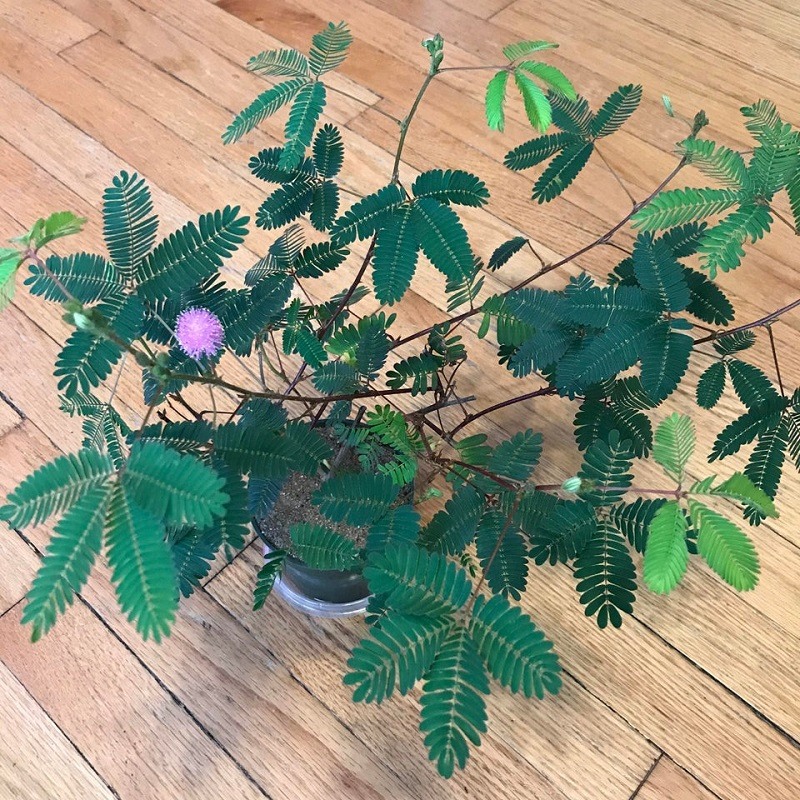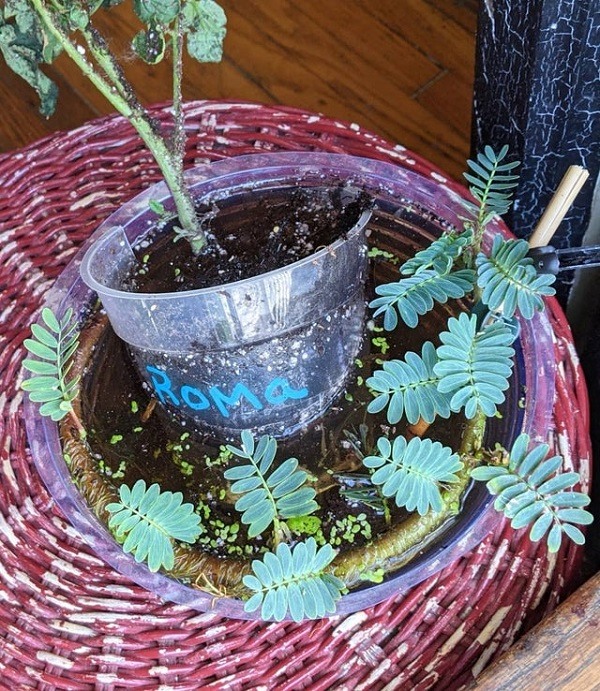A sensitive plant (mimosa pudica) is a creeping herb or shrub with intriguing leaf movement when touched. The plant has tiny hairs that are highly responsive to motion, touch, and temperature when triggered.
Sensitive plant care involves the provision of bright indirect sunlight, well-draining soil, high humidity, consistent soil moisture, and a temperature range of 60-85oF (16-30oC). Feed the houseplant every two weeks during spring and summer with liquid fertilizer.
Learning how to care for a sensitive plant is a no-brainer task. But the information in this comprehensive guide will help you provide solutions to the common problems. Take the time to read through it and find out all the answers about mimosa pudica.
You May Also Like: How to Care for Pilea Glauca Plant

What Does a Sensitive Plant (Mimosa Pudica) Look Like?
Mimosa pudica (sensitive plant) hails in the tropics of Southern and Central America. The tropical plant experiences intriguing leaf movement when touched.
The sensitive plant is highly responsive to motion, touch, and temperature. It usually folds inwards when triggered by these factors. The movement is part of a self-defense mechanism.
Mimosa pundica is an excellent houseplant due to its low maintenance. Besides that, the fern-like leaves with purple flowers make a lasting impression.
The houseplant tends to deteriorate after blooming. It is the reason behind the treatment as an annual plant rather than perennial.
Mimosa pudica propagation is through seeds. Viable seeds tend to grow faster into new plants with ultimate care provision. Growing sensitive plant from seeds is a no-brainer task.
The nastic movement is another reason behind the sporadic demand in the market. But this perennial plant is toxic to humans and pets.
Continue reading to learn how to care for the mimosa pudica at home. This sensitive plant houseplant care regime is worth your time.
Sensitive Plant Care Details
| Origin | Native to Central and Southern America |
| Scientific Name | Mimosa Pudica |
| Common Names | Sensitive plant Sleepy plant Action plant Touch-me-not plant Dormilones Zombie plant Shy plant Shy lady |
| Family | Fabaceae |
| Plant Type | Perennial creeping herbaceous shrub |
| Maximum Growth (approx) | 18-inch tall |
| Light Requirements | Bright indirect sunlight. But some species can tolerate direct sunlight. |
| Soil Type | Well-draining and loamy type. The soil pH range of 5.0 to 7.5 |
| Temperature Range | 60-85oF (16-30oC) |
| Humidity Requirement | 40-80% humidity level |
| Watering Needs | Consistently moist soil |
| Fertilizer Application | Feed the plant every two weeks during spring and summer. Use fertilizer rich in nitrogen and potassium. |
| Propagation | Growing from seeds or stem cuttings |
| Bloom | Produce purple-pink flowers in summer |
| Pests and Diseases | Pests: Spider mites Diseases: Leaf spot due to poor ventilation |
| Toxicity | Poisonous to pets and humans |
How to Care for Sensitive Plant (Mimosa Pudica)
Sensitive Plant Soil Requirements
Sensitive plants require well-draining soil with the ability to hold moisture. Adequate aeration and drainage help to prevent root rot caused by soggy soil.
Use equal parts of loam soil and peat moss to make a potting medium. Add one part of perlite to improve potting soil drainage.
I recommend the addition of compost to increase soil fertility. Adequate soil nutrients foster vegetative and active growth.
Best Pot for Sensitive Plant
Mimosa pudica is more vulnerable to root rot when grown in damp conditions. Use a pot with drainage holes at the bottom to get rid of excess water.
Use a 3-inch container for seedlings and 5-inch pots for established plants. A self-watering planter is another excellent option for regulating potting soil moisture.
Sensitive Plant Light Requirement
Mimosa pudica thrives in bright indirect sunlight. But other sensitive plants flourish under direct sunlight. Too much can scorch the plant foliages.
Low-light condition inhibits sensitive plants from blooming and foster leaves to close up. An East-facing window is an ideal location for your sensitive plant.
Use full-spectrum fluorescent grow light (Check Best Deals on Amazon) in rooms not receiving natural light. Keep the houseplant away from direct sunlight.
Sensitive Plant Temperature Range
Sensitive plants prefer a temperature range of 60-85oF (16-30oC) to germinate and maintain healthy growth. The temperature range also triggers flowering.
Keep the houseplant away from the window at night due to a decrease in temperature. Low temperature is known for weakening the houseplant and inhibiting blooming.
Use a digital thermometer (Check Best Deals on Amazon) to detect or monitor indoor temperature changes. Ensure the indoor temperature mimics the plant’s natural habitat.
Sensitive Plant Humidity Level
Sensitive plant is among tropical plants that thrive in high indoor humidity level. Other tropical plants can tolerate dry indoor environments.
High humidity keeps the mimosa pudica happy and healthy. Use a humidifier to boost indoor humidity levels due to changes in weather climate.
Ensure the room is well-ventilated to prevent the occurrence of fungal diseases due to high indoor humidity levels. Monitor the soil moisture content and avoid overwatering by all means.
How to Water Sensitive Plant
The sensitive plant prefers consistent soil moisture that is never soggy. Excess soil moisture increases the risk of root rot and other fungal diseases.
Inspect the potting mixture moisture before watering. Soak the potting soak until water runs through the drainage holes if it is dry.
Keep in mind that the houseplant uses more water in spring and summer due to active growth. Reduce watering frequency in winter due to the dormancy phase.
Mimos Pudica Fertilizer
Sensitive plant is capable of fixing nitrogen into the soil. It implies that the plant can thrive in soil with insufficient nutrients.
But you can use a diluted liquid fertilizer to encourage vegetative growth. Apply the fertilizer every two weeks during spring and summer.
I recommend the use of high-potassium fertilizer to provide adequate energy for nastic movement. Potassium nutrients enhance the generation, movement, and carbohydrate storage.
Sensitive Plant Propagation
Propagating sensitive plants is by seeds and stem cutting. Growing seeds is the quickest and reliable method for producing new plants.
Harvest mature seeds or buy from a reputable plant store. Plant the seeds in spring and provide adequate sunlight to foster germination.
Another option is to cut a branch with a leaf node and plant it in potting soil. Place in a bright spot and cover the pot with plastic for one to two weeks.
How to Prune Sensitive Plant
The sensitive plant requires minimal pruning only. Use a sharp pruner to remove dead or damaged leaves for better shape and size.
Be sure to cut leggy stems and branches to allow the houseplant to spread out with age. I recommend pruning the sensitive plant during spring.
How to Repot Mimosa Pudica
Sensitive plant is a fast-growing tropical plant and it can overgrow the pot within 1-2 years. An overgrown mimosa pudica results in root-bound issues.
Repotting is recommendable in spring to rejuvenate the houseplant. Remember to save the seeds for growing new plants. Use a pot slightly bigger than the current one.
Common Problems and Solutions
Pests
Sensitive plants are less vulnerable to pest infestations. But this does not imply that the houseplant is invincible to pests.
Spider mites are the leading sap-sucking insects that attack the sensitive plant. Use either horticultural oil or insecticidal soap to eradicate the pests.
Diseases
A damp environment makes the sensitive plant more vulnerable to fungal diseases. Provide high humidity and ventilation to help prevent fungal diseases.
Frequently Asked Questions
Is Sensitive Plant Toxic to Humans and Pets?
No. The houseplant is safe for humans and pets. Be sure to keep the houseplant away from pets and toddlers to avoid destruction. (Source: University of California).
Why Is My Sensitive Plant Dying?
Overwatering and under-watering are the leading causes. Overwatering results in root rot, while under-watering causes plant dehydration.
Reduce the watering frequency and use well-draining potting soil. Ensure the pot has drainage holes at the bottom to get rid of excess water.
Why Are My Sensitive Plant Leaves Curling?
Lack of sunlight and under-watering are the possible causes of leaves curling. Relocate the houseplant to a region with bright indirect sunlight and soak the potting soil for hydration.
Other possible causes are pests and diseases. Be sure to investigate the houseplant to determine the exact cause of the problem and fix it.
Why Do the Leaves of Sensitive Plants Close?
The reason behind the nastic movement is a mystery. Botanists are still undertaking research to find the mystery behind the sensitivity of the leaves.
Can I Grow Sensitive Plant Outdoor?
Not Really. A sensitive plant is an indoor plant. If you live in a tropical or subtropical climate, the houseplant can be grown in the yard.
But season growers in America, Canada, and United Kingdom cannot grow the sensitive plant in their yards due to weather-climate fluctuations.
How Long Does Sensitive Plant Take to Grow?
Sensitive plants can live for two or more years in tropical climates. Temperate climates make the houseplant live for a short period after blooming.

Final Word
Mimosa pudica (sensitive plant) is the best indoor plant for season growers and novice enthusiasts. The nastic movement is a self-defense mechanism against predators.
How to care for mimosa pudica involves the provision of bright indirect sunlight, high humidity, well-draining soil, and a temperature range of 60-85oF.
